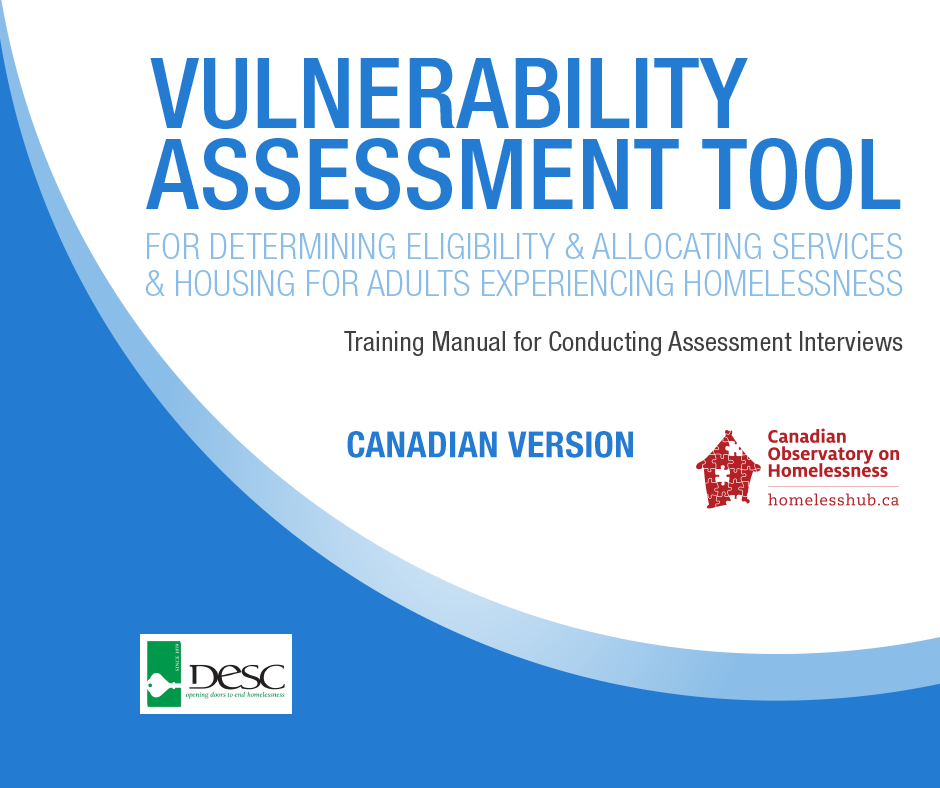Identifying and prioritizing adults experiencing chronic and episodic homelessness are two core components of the federal Homelessness Partnering Strategy (HPS) and many local Housing First plans. In 2015, a task force convened by the Canadian Observatory on Homelessness and the Mental Health Commission of Canada analyzed 15 tools and found that DESC’s Vulnerability Assessment Tool (VAT) was the best one available. Employment and Social Development Canada (ESDC) has integrated the VAT into HIFIS, offering Canadian service providers free software for recording VAT results and generating reports. In February, BC Housing is launching a time-limited, at-cost train-the-trainer program to support communities across Canada.
Today, the COH is releasing a training manual to support organizations that are interested in using the VAT. The VAT Training Sub-Committee revised DESC’s manual to reflect the Canadian context. All changes were reviewed and approved by DESC prior to publication.
Changes to the Vulnerability Assessment Tool
The VAT assesses a person’s level of vulnerability in ten domains: Survival Skills, Basic Needs, Indicated Mortality Risks, Medical Risks, Organization/Orientation, Mental Health, Substance Use, Communication, Social Behaviours and Homelessness.
In the Canadian version of the tool, only the three-point scale for Homelessness has been substantively revised:
- 1: Newly homeless and 2: Moderate history of homelessness. The ‘1’ and ‘2’ scores have been revised to reflect the Canadian definition of homelessness. The ‘2’ score has been expanded to include transitional housing, couch-surfing, and other forms of provisional accommodation.
- 3: Chronically and episodically homeless. The ‘3’ score is the HPS definition of ‘chronic and episodic homelessness’. This will make it easy to identify individuals in this priority population outside of other vulnerability factors. It will also facilitate data comparisons with the national Point-in-Time counts and other national publications.
These changes will have a minimal impact on VAT assessments; an individual’s score may vary by no more than one point between the Canadian version and the U.S. version.
Changes to the Training Manual
The manual has been lightly revised to reflect Canadian spellings and terms, and case studies have been updated to include Canadian examples. Some new material has been added on best practices for planning and implementing coordinated assessment processes.
Access to the Full Manual
The document shared on the Homeless Hub includes the Canadian version of the Vulnerability Assessment Tool and a few excerpts from the manual:
- Integrating the VAT into Canadian Housing First Approaches
- Checklist for Implementing Coordinated Assessment: What You Should Have in Place before You Use the VAT
- Background & Development of the VAT
- Ethical Use of the VAT – Strategies for Minimizing Harms and Maximizing Benefits
- Best Practices for Making Referrals and Following Up
Access to the full manual will only be available to individuals who participate in the training.
The full manual includes the interview script, procedures for conducting the interviews and instructions for scoring the results. It also includes a sample client consent form, VAT write-up template, trainee evaluation checklist, quality assurance forms and other tools for implementing the VAT.
Using the VAT
The VAT can provide a consistent and fair way to identify adults who would most benefit from intensive interventions, such as supportive housing and ongoing multi-disciplinary case management. It can help to coordinate services among agencies and prevent people from falling through the cracks in the system.
However, any assessment tool is only as effective and ethical as the people and the systems administering it. People with lived experience of homelessness need to be involved at every stage of the system design, implementation, administration and evaluation. Thoughtful consideration must be given to ways to minimize harms and maximize benefits to participants. Assessors must be trained to work from a strengths-based, person-centred and trauma-informed approach. All individuals who complete a VAT must receive some type of support to find housing and access other needed resources, even if they have not been prioritized for the primary resource being made available.
Any organization planning to implement the VAT must complete training by BC Housing or another certified VAT trainer.
Canada-Specific Training Opportunities
In February, BC Housing is launching a Canada-specific in-person training program. The three-day train-the-trainer program will be facilitated by certified trainers from Vancouver, BC, and delivered in local communities. No fees will be charged for the training sessions; however, host organizations or communities will be asked to cover expenses related to the trainers’ flights, accommodations, and meals.
BC Housing is offering these at-cost train-the-trainer sessions only for a limited time. Their goal is to certify multiple service providers to increase the availability of local training opportunities across Canada. If you are interested, please send inquiries to Will Valenciano, Housing and Health Services Manager, BC Housing, at wvalenci@bchousing.org or 604-648-4278.


